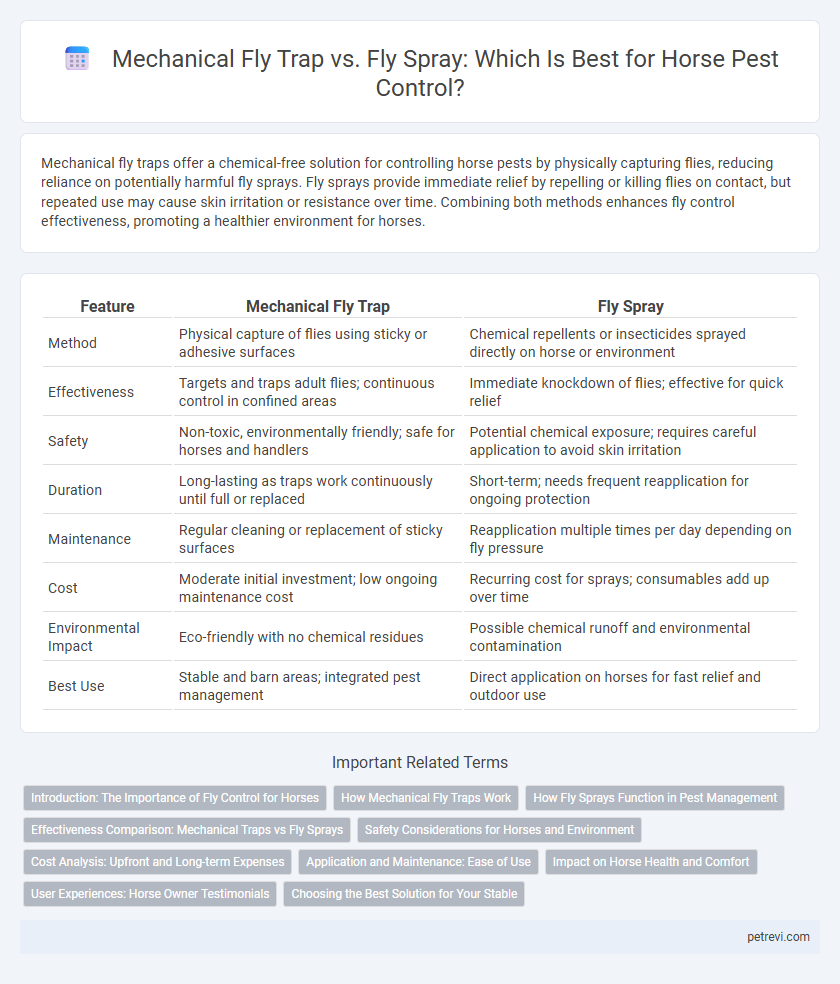Mechanical fly traps offer a chemical-free solution for controlling horse pests by physically capturing flies, reducing reliance on potentially harmful fly sprays. Fly sprays provide immediate relief by repelling or killing flies on contact, but repeated use may cause skin irritation or resistance over time. Combining both methods enhances fly control effectiveness, promoting a healthier environment for horses.
Table of Comparison
| Feature | Mechanical Fly Trap | Fly Spray |
|---|---|---|
| Method | Physical capture of flies using sticky or adhesive surfaces | Chemical repellents or insecticides sprayed directly on horse or environment |
| Effectiveness | Targets and traps adult flies; continuous control in confined areas | Immediate knockdown of flies; effective for quick relief |
| Safety | Non-toxic, environmentally friendly; safe for horses and handlers | Potential chemical exposure; requires careful application to avoid skin irritation |
| Duration | Long-lasting as traps work continuously until full or replaced | Short-term; needs frequent reapplication for ongoing protection |
| Maintenance | Regular cleaning or replacement of sticky surfaces | Reapplication multiple times per day depending on fly pressure |
| Cost | Moderate initial investment; low ongoing maintenance cost | Recurring cost for sprays; consumables add up over time |
| Environmental Impact | Eco-friendly with no chemical residues | Possible chemical runoff and environmental contamination |
| Best Use | Stable and barn areas; integrated pest management | Direct application on horses for fast relief and outdoor use |
Introduction: The Importance of Fly Control for Horses
Effective fly control is essential for maintaining horse health and comfort, as flies can transmit diseases and cause severe irritation. Mechanical fly traps capture pests without chemicals, reducing environmental impact and horse exposure to toxins. Fly sprays offer immediate relief but require frequent application and may contain harmful substances, highlighting the need for a balanced pest control strategy.
How Mechanical Fly Traps Work
Mechanical fly traps operate by attracting flies using specific lures such as light, color, or scent to mimic their natural habitats or food sources. Once drawn in, flies are either trapped on sticky surfaces or confined within the device, preventing their escape and reducing the overall fly population around horses. This method offers a sustainable, chemical-free solution for controlling horse pests, minimizing the risk of skin irritation and respiratory issues common with fly sprays.
How Fly Sprays Function in Pest Management
Fly sprays for horses function by releasing chemical agents that disrupt the sensory receptors or nervous systems of flying pests, effectively repelling or killing flies on contact. These sprays often contain pyrethroids, essential oils, or insect growth regulators targeted to interrupt fly activity and reproduction cycles. Regular application creates a protective barrier on the horse's coat, reducing irritation and the transmission of fly-borne diseases like summer sores and equine infectious anemia.
Effectiveness Comparison: Mechanical Traps vs Fly Sprays
Mechanical fly traps provide continuous, chemical-free pest control by physically capturing flies, proving highly effective in reducing fly populations around horses over time. Fly sprays deliver immediate, targeted repellency but require frequent applications and can cause skin irritation or resistance issues with prolonged use. Combining both methods enhances overall pest management by leveraging the long-term trapping efficiency of mechanical devices and the quick action of fly sprays.
Safety Considerations for Horses and Environment
Mechanical fly traps offer a non-toxic, environmentally friendly solution for controlling horse pests, eliminating risks associated with chemical exposure. Fly sprays often contain insecticides that can irritate a horse's skin, respiratory system, and eyes, posing health risks to both animals and handlers. Choosing mechanical traps reduces chemical runoff and contamination, promoting safer conditions for horses and surrounding ecosystems.
Cost Analysis: Upfront and Long-term Expenses
Mechanical fly traps require an initial purchase ranging from $30 to $100, with minimal ongoing costs aside from occasional maintenance or replacement parts. Fly sprays typically cost around $10 to $20 per bottle, needing frequent applications weekly or more depending on fly activity, leading to higher annual expenses. Over time, mechanical traps offer a more cost-effective solution for horse pest control by reducing recurring supply purchases compared to continuous fly spray use.
Application and Maintenance: Ease of Use
Mechanical fly traps require minimal maintenance, typically involving emptying and cleaning the trap regularly to maintain effectiveness, making them convenient for ongoing pest control in horse environments. Fly sprays offer immediate application with targeted coverage but demand frequent reapplication and careful handling to ensure safety for horses. Choosing between these methods depends on balancing the ease of continuous upkeep with the need for quick, versatile pest deterrence.
Impact on Horse Health and Comfort
Mechanical fly traps reduce chemical exposure, minimizing respiratory irritation and skin reactions in horses, promoting overall health. Fly sprays provide immediate pest control but may contain toxic substances that cause allergic responses, stress, or discomfort. Choosing mechanical traps supports a safer, more comfortable environment, enhancing equine welfare without compromising fly management effectiveness.
User Experiences: Horse Owner Testimonials
Horse owners emphasize that mechanical fly traps provide a chemical-free, eco-friendly solution for managing flies, minimizing horse skin irritation and health risks. Many users report that fly sprays offer immediate relief but require frequent reapplication, sometimes causing allergic reactions in sensitive horses. Overall, horse owner testimonials highlight the balance between effectiveness and safety, with mechanical traps praised for long-term pest reduction and sprays favored for quick, targeted control.
Choosing the Best Solution for Your Stable
Mechanical fly traps provide a chemical-free method for controlling horse pests, capturing flies effectively without exposing animals to toxins. Fly sprays offer immediate relief with insecticides that repel or kill flies on contact but require frequent application to maintain protection. Selecting the best solution depends on stable size, horse sensitivity to chemicals, and the severity of the fly problem.
Mechanical Fly Trap vs Fly Spray for Horse Pest Control Infographic

 petrevi.com
petrevi.com